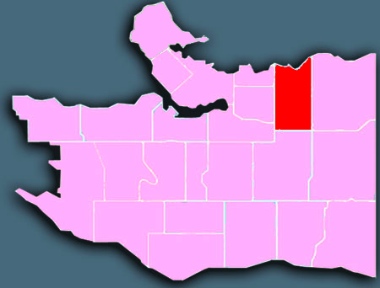 Grandview-Woodland is in the mid-northeast of Vancouver, extending from Clark Drive in the west to Nanaimo Street in the east, from Broadway in the south to Burrard Inlet in the north. Running through the centre of it is Commercial Drive, with its lively bohemian collection of cafes, ethnic restaurants, food markets and clothing stores.
Grandview-Woodland is in the mid-northeast of Vancouver, extending from Clark Drive in the west to Nanaimo Street in the east, from Broadway in the south to Burrard Inlet in the north. Running through the centre of it is Commercial Drive, with its lively bohemian collection of cafes, ethnic restaurants, food markets and clothing stores.
Demographics
From Statistics Canada, 2011 Census, custom order for City of Vancouver Local Areas (comparative data for Census Metro Area in parentheses).
population: 27,305 under 18: 13% (19%) aged 65+: 10% (13%)
married/common-law: 38% (48%) living alone: 23% (11%)
have kids at home: 23% (40%) lone parents: 1,285 widows: 795
ESL: 32% (44%) mother tongues: Cantonese 6%, unspecified Chinese 4%, Spanish 2% French 2%, Italian 2%
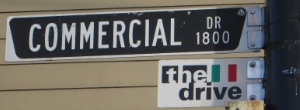 Given the long, layered history of immigration to ‘The Drive,’ it is surprising that English is the mother tongue of such a large majority of residents.
Given the long, layered history of immigration to ‘The Drive,’ it is surprising that English is the mother tongue of such a large majority of residents.
Grandview is a ‘gateway’ for Indigenous people arriving from and returning to their reserves and other parts of the city region. They are drawn in part by the large quantity of social housing, some of which is owned or managed by Indigenous agencies, in the northern and western quadrants of the neighbourhood. The availability of affordable housing means that more low income (and single mother) households live here than anywhere else except the Downtown Eastside.
However, the area’s hip reputation and its large heritage homes have attracted the ‘cultural creative class’ and upwardly mobile professionals, leading to sharp gentrification over the past decade.
History
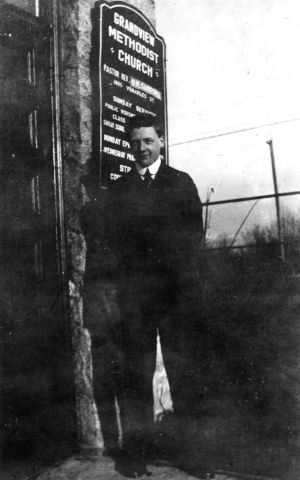
Amateur photographer Walter Edwin Frost at entrance to Grandview Methodist Church – 1895 Venables Street, now The Cultch (Vancouver East Cultural Centre). Vancouver Archives: AM1506-S1-: CVA 447-6 (photo: W.E. Frost).
During the city’s first decades, the area’s hilly viewpoints and cedar woods were favourite destinations for pleasure outings. These natural features attracted the professional class to build clusters of stately homes, but development of the neighbourhood did not take off until the Interurban Tram – linking Vancouver and New Westminster – was built in 1891.
The tramway ran east from downtown along Venables and then turned south to follow a ‘skid road’ that had long carried cedar logs downhill from Hastings Street to sawmills on Burrard Inlet. That road then was christened Park Drive, because it headed straight to Clark Park at 14th Avenue (one of the prime picnic viewpoints), before being renamed Commercial Drive in 1911.
By 1905 the whole area had been clear-cut logged and was booming as a predominately working class neighbourhood, even as land speculators – who built the tram – kept up interest among the wealthy.
After the Second World War, ‘The Drive’ became known as ‘Little Italy’ when the original Italian community moved east from downtown and was joined by new immigrants.
Notable features
Diversity: There are still many signs of Italian influence (several of the coffee bars, bocce ball in the park), but new waves of immigrants (Vietnamese Boat People in the 70s, Chinese, eastern Europeans, South Americans and Filipinos in the 80s and 90s) – plus large contingents of artists, students and counter-cultural activists – have earned The Drive its reputation for being remarkably diverse yet tolerant and hip.
Stretched social fabric. Grandview’s community ethic is woven tightly into its character. Residents aren’t just tolerant of their differences; they report strong habits of ‘looking out for one another.’
That has translated into numerous innovative community-based service agencies and facilities, such as Britannia Community Centre (the largest non-municipal community centre complex in North America at the time it was built in 1975).
These enjoy a high degree of collaboration and resident good-will, but they are operating at maximum capacity and are unable to respond to new needs arising from changing demographics. Gentrification is also straining the socio-economic balance that has made for so much of the area’s unique vibe and strength.
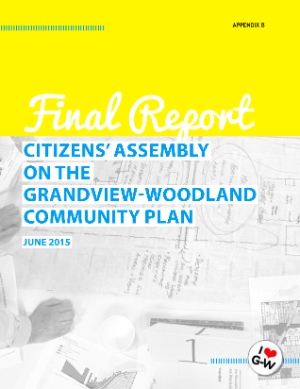 Grandview-Woodland Community Plan: There has been much debate and delay as the city has tried to move ahead with the Grandview-Woodland Community Plan. The process was derailed in 2013, when the community learned that the city intended to include towers as high as 36-storeys near the Commercial-Broadway SkyTrain station.
Grandview-Woodland Community Plan: There has been much debate and delay as the city has tried to move ahead with the Grandview-Woodland Community Plan. The process was derailed in 2013, when the community learned that the city intended to include towers as high as 36-storeys near the Commercial-Broadway SkyTrain station.
The city appointed a Grandview-Woodland Citizens’ Assembly, which produced a comprehensive 75-page report in June. Among other things, it concluded that 12-storey towers would be acceptable to the community.
Rachel Magnusson, chair of the citizen’s assembly, gave a sense of the magnitude and scope of the work:
Together, the 43 members of the Assembly contributed some 5,000 hours of unpaid time over the course of 11 Saturday sessions and additional public meetings. This extraordinary commitment of civic energy is perhaps the best response to anyone who doubts the capacity or resourcefulness of Vancouver residents to play a constructive role in shaping the policies and plans that in turn shape our city.
The members of the Grandview-Woodland Citizens’ Assembly wrestled with many of most challenging issues facing cities today: How do we make it easier and safer for more people to walk, bike or use public transportation? How does a city make room for new residents without displacing others? How can a community retain its character as well as its local businesses in the face of growing economic pressure?
For a link to the citizen’s assembly report, go here. The city has stated: “A response is expected to be shared in the late fall or early winter, as staff work towards incorporating all input into a revised community plan.”
Churches
Bethany Indonesian; Chinese Grace Mennonite; Coastal Commercial Drive; Grandview Calvary Baptist; Indonesian Evangelical; Korean First Presbyterian; More Than 12; New Beginnings Baptist; Our Lady of Hungary Catholic; St. Francis of Assisi Catholic; St. John of Shanghai Orthodox; Vancouver Chinese MB; Vancouver Mandarin. See map.
Here are some ways in which Grandview churches are linked to their neighbourhood. The list is far from complete and we would love to hear about other examples:
* Coastal Church Commercial Drive, just northwest of Broadway and Commercial, just opened up earlier this year, but – along with the other three Coastal campuses – it supports Whole Way House at the Avalon Hotel in the Downtown Eastside, Union Gospel Mission and the Vancouver Food Bank.
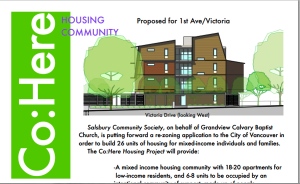
The Co:Here Housing Community plans to develop 26 units of affordable community housing on land owned by Grandview at 1st and Victoria.
* Grandview Calvary Baptist Church, on 1st Avenue one block east of Commercial, is probably the most socially active church in the city.
It initiated or participates in several ministries, including Crossroads Community Meal, MOMS (Mothers Offering Mentorship & Support), CLEAN Break (laundry program), Salsbury Community Society (with two intentional community homes), Kinbrace Refugee Housing & Support, Still Point Urban Retreat Centre, Co:Here Housing Community, REED (Resist Exploitation, Embrace Dignity), JustWork Economic Initiative and the Potter’s House Studio.

Hundreds of neighbours joined New Beginnings Baptist Church for their Praise in the Park gatherings in June and September.
* New Beginnings Baptist Church, just southeast of Hastings and Clark, offers the Say Yes! after school tutoring program, meals for local families and summer camps for children. Twice a year, they also hold large Praise in the Park events in Woodland Park, right across from the church.
Further reading
Some good sites to check out:
* The Courier did several articles on Grandview as part of a year-long series of articles on Vancouver neighbourhoods in 2013/2014.
* The city has a Grandview page.
* The East Village Business Improvement Area covers a stretch surrounding Hastings Street running from Grandview to Hastings-Sunrise.

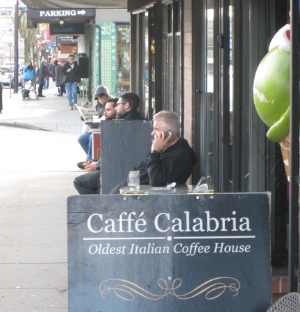
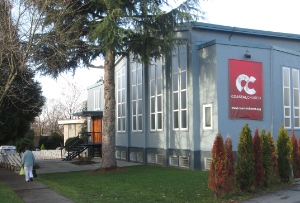
Excellent article! Well done and thank you for the post.